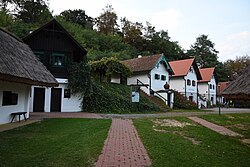Moschendorf
 From Wikipedia the free encyclopedia
From Wikipedia the free encyclopedia
Moschendorf | |
|---|---|
 Wine cellars and wine museum in Moschendorf | |
 Location within Güssing district | |
| Coordinates: 47°3′16″N 16°28′45″E / 47.05444°N 16.47917°E | |
| Country | Austria |
| State | Burgenland |
| District | Güssing |
| Government | |
| • Mayor | Thomas Behm (ÖVP) |
| Area | |
| • Total | 13.18 km2 (5.09 sq mi) |
| Population (2018-01-01)[2] | |
| • Total | 400 |
| • Density | 30/km2 (79/sq mi) |
| Time zone | UTC+1 (CET) |
| • Summer (DST) | UTC+2 (CEST) |
| Postal code | 7540 |
Moschendorf (Hungarian: Nagysároslak, Német-Sároslak) is a town in the district of Güssing in the Austrian state of Burgenland.
The place was originally known as "Lak", or habitation, dwelling as far back as the 13th century. In 1482 it became Saroslak, essentially meaning boggy habitation. The actual name of Moschendorf first appeared sometime in the 17th century when it was first documented as Mos, Moos, or in English Moor. Mos-chen-dorf was probably used to indicate its nature as a habitation or dwelling within a small peaty bog or moor. The initial landlords of Moschendorf were the Batthyány of Güssing, and then in the 17th century they ruled from Körmend. The 17th century was a difficult period for many in Moschendorf. It is during this time that the population was decreased to two-thirds its original size due to wars, pestilence and occasionally flooding from the nearby river, the Pinka. It was not until the 18th century that the development of the town truly began.
Population
[edit]| Year | Pop. | ±% |
|---|---|---|
| 1869 | 841 | — |
| 1880 | 830 | −1.3% |
| 1890 | 940 | +13.3% |
| 1900 | 979 | +4.1% |
| 1910 | 884 | −9.7% |
| 1923 | 852 | −3.6% |
| 1934 | 784 | −8.0% |
| 1939 | 746 | −4.8% |
| 1951 | 660 | −11.5% |
| 1961 | 617 | −6.5% |
| 1971 | 561 | −9.1% |
| 1981 | 469 | −16.4% |
| 1991 | 453 | −3.4% |
| 2001 | 453 | +0.0% |
| 2011 | 412 | −9.1% |
| 2021 | 386 | −6.3% |
References
[edit]- ^ "Dauersiedlungsraum der Gemeinden Politischen Bezirke und Bundesländer - Gebietsstand 1.1.2018". Statistics Austria. Retrieved 10 March 2019.
- ^ "Einwohnerzahl 1.1.2018 nach Gemeinden mit Status, Gebietsstand 1.1.2018". Statistics Austria. Retrieved 9 March 2019.
